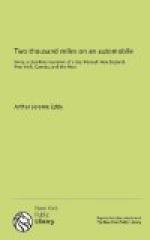The criminal action and the criminal advice must be dissociated entirely from any political or social theory. It does not matter what a man’s ultimate purpose may be; he may be a communist or a socialist, a Republican or a Democrat, a Presbyterian or an Episcopalian; when he advises, commits, or condones a murder, his conduct is not measured by his convictions,—unless, of course, he is insane; his advice is measured by its probable and actual consequences; his deeds speak for themselves.
A man is not to be punished or silenced for saying he believes in anarchy, his convictions on that point are a matter of indifference to those who believe otherwise. But a man is to be punished for saying or doing things which result in injuring others; and the advice, whether given in person to the individual who commits the deed, or given generally in lecture or print, if it moves the individual to action, is equally criminal.
On August 20, 1886, eight men were found guilty of murder in Chicago, seven were condemned to death and one to the penitentiary; four were afterwards hanged, one killed himself in jail, and three were imprisoned.
These men were convicted of a crime with which, so far as the evidence showed, they had no direct connection; but their speeches, writings, and conduct prior to the actual commission of the crime had been such that they were held guilty of having incited the murder.
During the spring of 1886 there were many strikes and a great deal of excitement growing out of the “eight-hour movement in Chicago.” There was much disorder. On the evening of May 4 a meeting was held in what was known as Haymarket Square, at this meeting three of the condemned made speeches. About ten o’clock a platoon of police marched to the Square, halted a short distance from the wagon where the speakers were, and an officer commanded the meeting to immediately and peaceably disperse. Thereupon a bomb was thrown from near the wagon into the ranks of the policemen, where it exploded, killing and wounding a number.
The man who threw the bomb was never positively identified, but it was probably one Rudolph Schnaubelt, who disappeared. At all events, the condemned were not connected with the actual throwing; they were convicted upon the theory that they were co-conspirators with him by reason of their speeches, writings, and conduct which influenced his conduct.
An even broader doctrine of liability is announced in the following paragraph from the opinion of the Supreme Court of Illinois:
“If the defendants, as a means of bringing about the social revolution and as a part of the larger conspiracy to effect such revolution, also conspired to excite classes of workingmen in Chicago into sedition, tumult, and riot, and to the use of deadly weapons and the taking of human life, and for the purpose of producing such tumult, riot, use of weapons and taking of life, advised and encouraged such classes by newspaper articles and speeches to murder the authorities of the city, and a murder of a policeman resulted from such advice and encouragement, then defendants are responsible therefor.”




